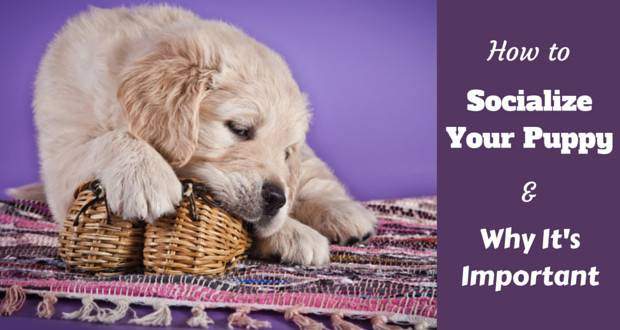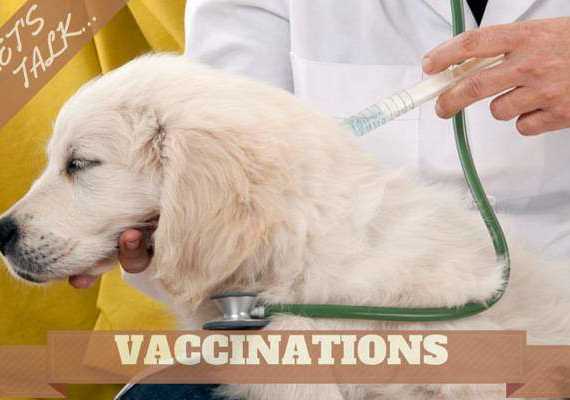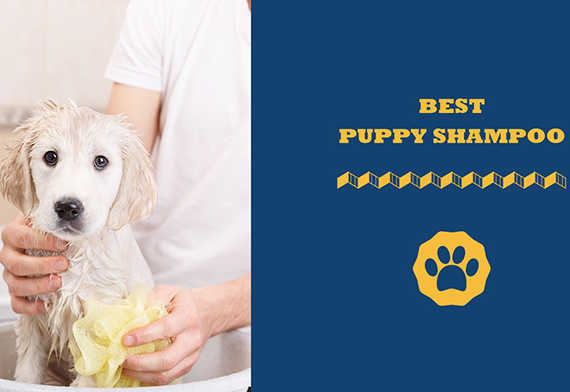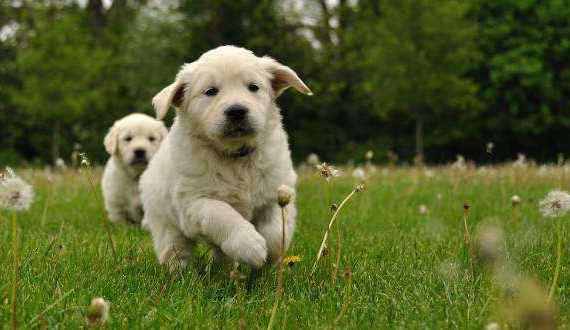Updated: August 10th, 2022

Photo Credit: © Depositphotos.com / averyanova
You go for a nice jog in the park. As you notice the bright flowers and warm breezes, you see up ahead someone walking with their dog coming toward you.
As the distance between shortens, the dog’s ears flatten, the tail tucks and the poor pooch springs off the trail into the weeds as you jog past.
As you continue, you glance back to see the trembling animal paralyzed and staring back at you, worried you will come back for the next “attack.”
You feel sorry for the dog, as it’s obvious that despite the peaceful park setting, he’s absolutely terrified. The saddest part of this story is this fearful reaction could have been avoided if this dog was properly socialized as a puppy.
What is Puppy Socialization?
Puppy socialization is, at its core, teaching your puppy during their critical learning weeks that the world is a safe and fun place.
From birth to 18 weeks, your Golden Retriever puppy’s brain is like a huge mainframe computer taking in and recording everything!
That’s not to say that they don’t still learn after this period, but this is the magic hour in the puppy’s life where they aren’t easily scared. It’s a perfect time to show them all the good in the world and reinforce that lack of fear through positive experiences.
Why is Puppy Socialization So Important?
Puppy socialization is critical for the health and well-being of your canine companion. If you want them to be able to integrate into your life, and not be excluded due to fear, socialization is key. Here are two main reasons you should train your dog to be more social.
1) It Creates a Happy Dog
Socialization is critical for your dog’s life-long happiness.
If you’ve ever watched an under-socialized dog try to handle life, it’s heartbreaking. They live in fear of new sounds, people and experiences. While they may feel comfortable in their home environment, trips to the vet or any travel or change terrify them.
Most owners of under-socialized dogs don’t include them in activities outside of the home because they are so afraid.
Shy dogs can also determine in their minds that since everything is scary, a good offense is better than defense. Some shy dogs develop fear aggression. This issue can get so severe that it may cause them to bite strangers that try to pet them.
If these dogs ever end up in shelters, most won’t pass the temperament test to get adopted and will be euthanized.
In contrast, well-socialized dogs have learned that people are fun to get to know and adventure is exciting. They bound into cars and meet new people with gusto.
These dogs live happier lives, and we owe it to them to make sure they are set up to gain this outcome as adults.
2) It Creates a Happy Owner
If you socialize your puppy early, you will enjoy being a dog owner so much more.
If you’ve ever owned a shy dog, it’s a very stressful experience. If they develop fear aggression, you constantly have to manage them to make sure they aren’t aggressive or scared by new experiences.
Since change is inevitable, and sometimes strangers – like veterinarians – will have to work with your dog, this means you have to witness your dog’s severe lack of coping skills throughout life. You also have to always worry that they will lash out and you will be liable for their aggression.
Finally, you can’t experience the full spectrum of life with your furry friend. You will be nervous about taking them to new places and will leave them at home because everything scares them.
If you take the time to socialize your puppy, you will get to enjoy relaxing at a park picnic together and meeting new people. You can involve them in fun activities like flyball or agility. You can take them on road trips and let them experience all the fullness of life.
Isn’t that the way life with a dog should be?
How to Socialize Your Puppy
We should now be on the same page that socialization is important for both the dog and owner. Now that you know the “why” of socialization, let’s examine the “how.”
It Starts With a Good Breeder
If you are getting your puppy from a breeder, try to find one that works with puppies before they leave their mom. Breeders can safely expose puppies to handling for grooming or vet care, let other safe people and dogs interact with them, or expose them to different surfaces, objects or noises.
Good breeders recognize the short window to expose the puppy to positive experiences, and they capitalize on it to give their customer’s dogs the best future possible.
Keep People, Pups and Places Positive
According to the ASPCA, after a puppy reaches 18 weeks, it becomes more of a challenge to convince them that all new experiences are fun.
However, if you’ve already shown them how fun new people, other pups and places can be, you may not even notice when this developmental shift occurs because you’ve already sold them on going out on the town with you.
People
Allow your puppy to interact with positive people who shower them with play, pets and treats. Let them meet men, women and younger kids who know how to interact positively with puppies. Let the puppy discover it’s fun. Don’t force them.
Pleasant Pups
Let your puppy play with healthy, vaccinated older dogs and other puppies to teach them that dogs – in addition to their litter mates – are also fun! Make sure these other dogs will be friendly to your puppy.
Try to keep the size and energy level equal. For example, don’t put your 10-week old pup in the room with a 9-month old mastiff puppy that may play too rough!
However, if you have an older senior mastiff that you know is safe around puppies, feel free to let the little one experience a bigger dog. You can have play dates at your home or theirs, but it’s always fun to let your puppy make more canine friends.
Populated Places
Take your puppy lots of new places. You can have them visit friend’s homes, ride in your car and take walks around the neighborhood.
Let them experience the noise of traffic, feel the whoosh of wind when a skateboarder or biker flies around you, and sit with you at an outdoor café and watch a wheelchair roll past your table.
If the weather is nice, take them to a lake for a swim or a ball field to watch kids play.
Don’t forget that training and puppy socialization classes are also great places to have supervised, controlled experiences that help your puppy learn that the world outside your house is just a bigger playground.
Reduce Stress
When you’re taking your furry bundle out into the world, make sure they don’t get too stressed. All of these new experiences must remain positive.
While not socializing a puppy can cause fear later in life, a negative experience during this impressionable period can have a similar impact if not handled correctly.
Don’t let your puppy interact with any person or dog that will hurt or scare them. Don’t allow them to be in dangerous environments.
Keep the experiences short. Remember, your puppy is still a baby and needs breaks. As they grow, you can lengthen the time of the interactions.
Watch for signs of stress in your puppy that signal that they’ve had enough. If a puppy is enjoying the experience, the ears will be up, the eyes will be bright and the tail will be wagging.
However, if you notice your puppy cowering, turning away from people, licking their lips or yawning to relieve stress, they may be shutting down.
Try to end on a positive note with something they like, such as a treat, and then remove them from the situation to keep things fun but also give them down time.
Focus On Fun Over Fear
Don’t worry! You are not expected to control every particle of matter your puppy encounters. After all, life happens!
During this time, there may be something that happens that you can’t control. You may be out with friends and someone accidentally steps on your puppy’s tail, causing it to yelp. Your puppy may get lost while on a run at the park, but likelihood is he’ll find his back back to you, or a kind stranger will report a stray dog and you’ll be reunited soon enough.
What do you do?
Redirect, keep things positive and don’t reward fear. Dogs live in the moment. As soon as their little tail stops throbbing, they are on to the next thing.
Your job is to move them out of the experience quickly. Redirect them with a fun command, toy or treat. Talk positively to them and let them know that everything is fine.
Dogs read human emotions very well. If you get nervous and scared, so will they. If you remain calm, they will take that cue from you.
One of the worst mistakes people make is petting dogs when they are afraid. It simply reinforces the behavior. The puppy learns that you praise them when they cower and tremble.
All you’re doing when you comfort a puppy is teaching them that a fear response equals praise. Just like any other training, you will get what you reinforce.
How to Overcome Fear
While it’s good not to push a puppy if they are afraid, it’s also important to note what they are afraid of and address it if necessary.
For example, if your puppy gets scared around crowds of people, and you want them to be able to handle walking through crowds as an adult, you need to slowly introduce groups of people over a period of time.
You can start to help your puppy manage the stress by playing with them or putting them through a training exercise with the crowds off in the distance. Then, gradually move closer over time doing the same activity with their attention on you.
The training, treats or play give the puppy something else to focus on other than the thing that scares them.
Once they are comfortable training or playing with you and can reach the crowd while still staying relaxed, have friends in the crowd drop or give treats for your puppy to continue the positive trend.
You can use this gradual conditioning approach with most challenges.
A Word About Vaccinations
It is highly possible that when you get your puppy, they may not have completed all of their vaccinations yet. There are some very nasty diseases out there, and you want to make sure you and your pup avoid them.
It’s ultimately up to you and your vet to determine the risk level.
On the one hand, taking your puppy out into the world before they are fully vaccinated increases their risk of exposure to illness. Yet, keeping them inside during this critical time hampers their emotional development and confidence.
However, if you make sure they only interact with vaccinated and healthy dogs, their risk should be fairly low. You can also avoid places where unvaccinated dogs may frequent, such as dog parks or places where strays like to hang out.
If you are concerned about the safety of a certain location, you can always carry your puppy and still let them experience the location from your lap or a carrier to keep them from picking up pathogens from the ground or another dog.
While you shouldn’t let fear of disease keep you from giving your pup fun experiences, you should still be cognizant of the danger of disease and manage the risk appropriately.
Conclusion
Socializing your puppy can be a rewarding experience as you become their pack leader and introduce them to their new community.
It’s up to you to make sure you don’t limit their existence to the walls of your home. Dogs deserve a much bigger world!
While it may seem daunting to socialize your puppy during these critical few weeks, your future self and future dog will thank you! A bit of effort during puppyhood will produce a well-adjusted canine co-pilot for all of life’s adventures!



